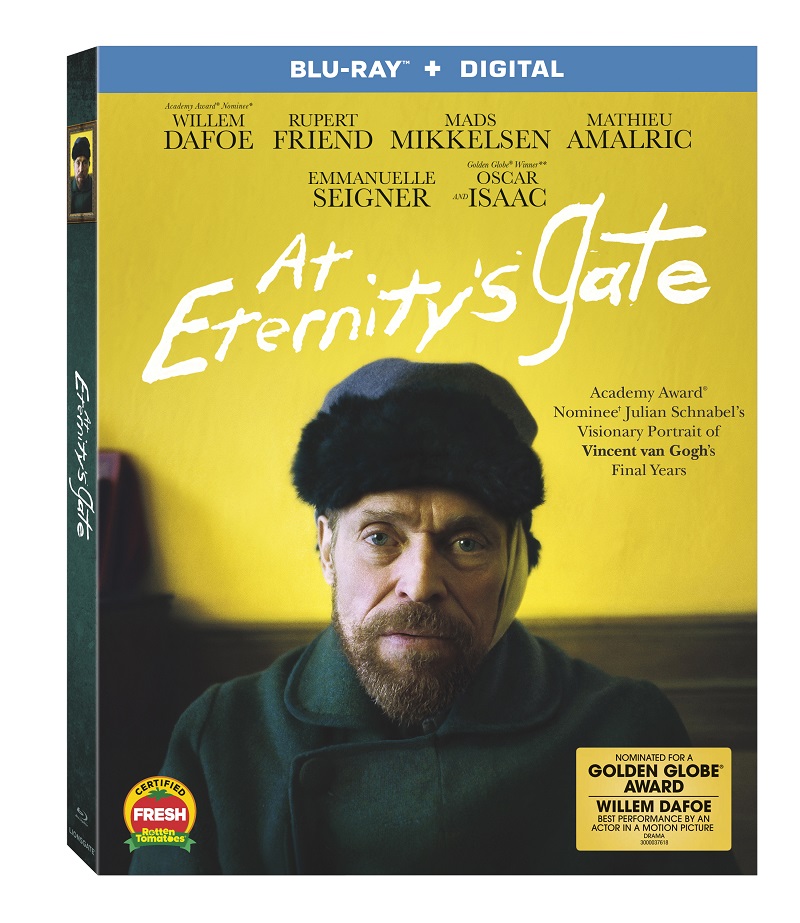Once in a while, a film comes along that challenges what the art of film can achieve. At Eternity’s Gate, out now on Blu-Ray, DVD and digital download, is one of those. It tells the story of one of the art world’s greatest and most gifted painters, Vincent van Gogh. Expertly played by Willem Dafoe (who earned an Oscar nod for the role).

This is no “true” biopic of the iconic painter. At Eternity’s Gate focuses on the final few years of his life as he dealt with the challenge of mental illness and coming to terms with the idea that his work will be more appreciated after he’s left this earth than while he was still on it. The artistic combination of director Julian Schnabel and Dafoe is a titanic tandem of talent that collectively brings the beloved artist’s rich thoughts, spectrum ranging emotions and surprising pervasive loneliness in a manner that is priceless.
To back up, the film spotlights van Gogh as he meets a fellow artisan, Paul Gauguin (passionately portrayed by Oscar Isaac), who informs Dafoe’s character that he is an inspiration and that his work is to be treasured. Gauguin encourages his new friend to head to the south of France for inspiration to feed the fire that van Gogh fears is waning.
What is so terrific is the choices made by co-writer and director Schnabel in how he portrayed how the beloved artist worked. It is the rare film that can expertly showcase what goes on in the head of a creative type—whether they be a writer, actor or yes, painter. At Eternity’s Gate does so in the most triumphant of ways. There have been many a van Gogh movie, but few achieved what Schnabel and Dafoe do in how they join forces to get us inside the thinking process of those extraordinary works that the artist crafted during these final moments of his career and life.
Just as they were expertly able to capture the artistic process of an elusive genius, they too paint a picture of mental illness that few films are able to effectively capture. There is a sensitivity to how it is portrayed that also has been rare in stories told about souls whose major challenge lies deep inside their psyche.
As has been portrayed many a time prior, van Gogh famously cut off his ear—something even non-artistic fans know about the painter. No film that we can recall more expertly explores the deeper reasons as to why the painter did what he did. Has “loneliness” ever been put at the forefront of an explanation? No, and through At Eternity’s Gate, it is not simply a theme to the overall arc of the film, but it serves as a bellwether belief as to answering the “why” behind the infamous ear issue.
When van Gogh checks himself into a church run asylum, it provides some great scenes by two of our favorite actors—Dafoe and Mads Mikkelsen (who recently blew us away in Arctic). The latter portrays a priest who is charged with determining whether the painter is safe to return to society or whether he will harm himself or others. The duo put on an acting clinic in these moments that are just one of many thespian triumphs that are strewn throughout the film.
The cast that supports Dafoe is sublime. Beyond Mikkelsen and Isaac, there is also stellar work turned in by Rupert Friend.
The highlight of the bonus features is Made by a Painter. It is the first of three featurettes that explores the making of the film from the point of view of getting the director and stars’ thoughts on why they felt this was an important tale to tell. When the discussion turns to Schnabel’s direction and how he shot the film, things get really fascinating.
Channeling van Gogh celebrates the Oscar nominated work of Dafoe. The director and supporting players all chime in about their front-row seat to witnessing Dafoe’s divine work as the celebrated artist. When the actor himself gets to speak, I was taken by the utter adoration he felt towards the character and the sense of duty he took with him to the set each day to bring him to life in a manner that has never been seen previously.
The final featurette, Vision of van Gogh, is a terrific—albeit too short—look at how the film itself was shot by the cinematographer. Benoît Delhomme’s work is celebrated, as it should be, for how the artistry of the artist was factored into how each scene was captured.
Also, cannot conclude this review without playing up the Audio Commentary with Director Julian Schnabel and Co-Writer and Editor Louise Kugelberg. There is insight, and then there’s what these artists have provided the viewer.
Film grade: A-
Bonus features: B+

